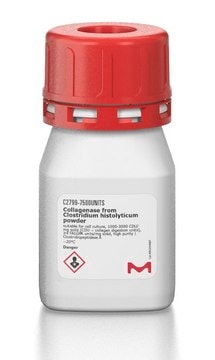C1889
Collagenase from Clostridium histolyticum
0.2 μm filtered, suitable for release of physiologically active rat hepatocytes, Type IV-S, 0.5-5.0 FALGPA units/mg solid, ≥125 CDU/mg solid
Synonim(y):
Clostridiopeptidase A
About This Item
Polecane produkty
Poziom jakości
sterylność
0.2 μm filtered
typ
Type IV-S
Postać
powder
aktywność właściwa
≥125 CDU/mg solid
0.5-5.0 FALGPA units/mg solid
masa cząsteczkowa
68-130 kDa
przydatność
suitable for release of physiologically active rat hepatocytes
Zastosowanie
diagnostic assay manufacturing
temp. przechowywania
−20°C
Szukasz podobnych produktów? Odwiedź Przewodnik dotyczący porównywania produktów
Powiązane kategorie
Opis ogólny
Zastosowanie
Działania biochem./fizjol.
Przestroga
Definicja jednostki
Uwaga dotycząca przygotowania
enzym
inhibitor
substrat
Hasło ostrzegawcze
Danger
Zwroty wskazujące rodzaj zagrożenia
Zwroty wskazujące środki ostrożności
Klasyfikacja zagrożeń
Eye Irrit. 2 - Resp. Sens. 1 - Skin Irrit. 2 - STOT SE 3
Organy docelowe
Respiratory system
Kod klasy składowania
11 - Combustible Solids
Klasa zagrożenia wodnego (WGK)
WGK 1
Temperatura zapłonu (°F)
Not applicable
Temperatura zapłonu (°C)
Not applicable
Środki ochrony indywidualnej
dust mask type N95 (US), Eyeshields, Faceshields, Gloves
Certyfikaty analizy (CoA)
Poszukaj Certyfikaty analizy (CoA), wpisując numer partii/serii produktów. Numery serii i partii można znaleźć na etykiecie produktu po słowach „seria” lub „partia”.
Masz już ten produkt?
Dokumenty związane z niedawno zakupionymi produktami zostały zamieszczone w Bibliotece dokumentów.
Klienci oglądali również te produkty
Protokoły
To measure collagenase activity, N-(3-[2-Furyl]acryloyl)-Leu-Gly-Pro-Ala is used in a continuous spectrophotometric rate determination at 345 nm. Collagenase hydrolyzes collagen peptide bonds.
Nasz zespół naukowców ma doświadczenie we wszystkich obszarach badań, w tym w naukach przyrodniczych, materiałoznawstwie, syntezie chemicznej, chromatografii, analityce i wielu innych dziedzinach.
Skontaktuj się z zespołem ds. pomocy technicznej









